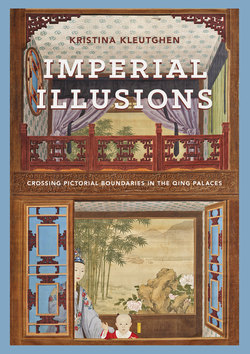Читать книгу Imperial Illusions - Kristina Kleutghen - Страница 43
На сайте Литреса книга снята с продажи.
Оглавление“technology” (jishu), which was the domain of the professionally trained muralist rather than the amateur literati painter. The magic of illusionistic murals was therefore inseparable from the techniques used to create them. Perhaps this rejection was also a means of demonstrating superior intellect: as was the case with European illusionistic paintings, the ignorant were prone to such credulousness, while the educated were less gullible, as “diffidence toward what is immediately perceived is the prerogative of the learned.”34 If scholars such as Guo Ruoxu and Su Shi wanted to distinguish their educated selves from the uneducated masses by what types of paintings they looked at and how they did so, then perhaps the Northern Song literati ability to differentiate reality from illusion in these paintings was also a key means of social differentiation.
Beginning in the late eleventh century, therefore, the importance and presence of murals were both in inexorable decline: muralists had become artisans at best and mere wall painters at worst. Growing through the Southern Song and Yuan dynasties, by the start of the Ming dynasty, connoisseurs were firmly against both murals and muralists.35 An anecdote about the literatus and painter Shen Zhou (1427–1509) reveals just how deep the divide had become. When, in order to humiliate him, one of Shen’s enemies submitted Shen’s name in response to a call for muralists to decorate the walls of a governor’s new public building, Shen’s friends encouraged him to use his connections to be excused from such “menial labor.” Shen graciously yet discreetly completed the task, but upon discovering just how large a faux pas had been committed, the governor apologized to the literatus. “You did not summon a [literatus like] Shen Zhou to paint a wall. Gentlemen did not do walls.36 What literati gentlemen like Shen Zhou did paint, and the style they used to do so, were later codified into a theory of artistic repossession of the past by painter and theorist Dong Qichang (1555–1636).37 Amid the factionalism that plagued the declining Ming court and its officials, Dong emphasized a return to brushwork doubly rooted in calligraphy and the works of certain ancient masters, thereby retroactively constructing a lineage of literati painting. Beginning with the Tang poet and painter Wang Wei (701–61), it ran through the tenth century “southern-style” landscape masters, paused during the Song emphasis on formlikeness, and picked up with Zhao Mengfu (1254–1322) to continue through the Yuan literati landscape masters and early Ming literati like Shen Zhou, and ended with Dong himself in the late Ming. The reintegration of Yuan calligraphic brushwork as ink texture strokes to model landscape forms (rather than using tone and shading) thereby produced paintings with “momentum” (shi), which was considered superior to mimesis. With calligraphy as the driving force, Dong sought a “Great Synthesis” (dacheng) of historical painting styles that privileged the calligraphic lineage of the Yuan literati over the realism of Song professional painters, all while emphasizing the contemporary Ming artist’s originality.38 This height of literati aesthetic theorization occurred at a time when elite ability to distinguish reality from illusion and true literati from those with merely literati trappings became a significant cultural practice for this same group, further linking painting practice with social differentiation.39
